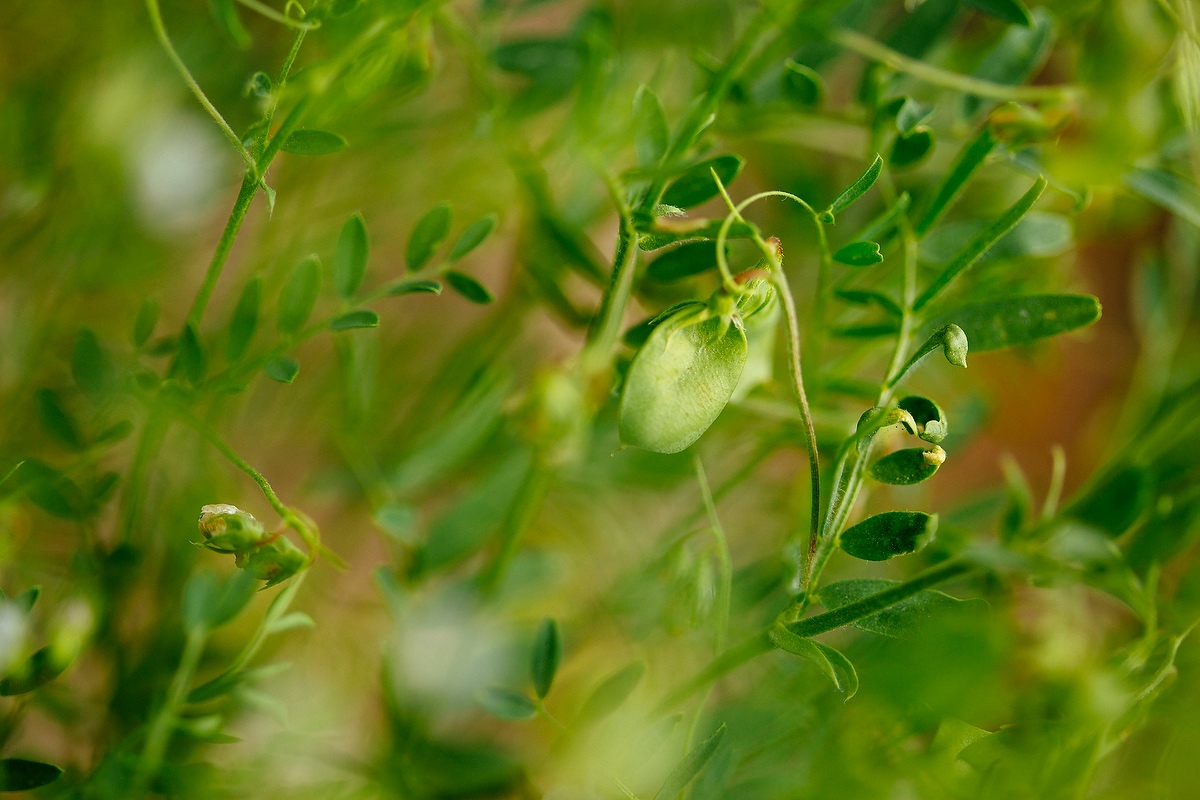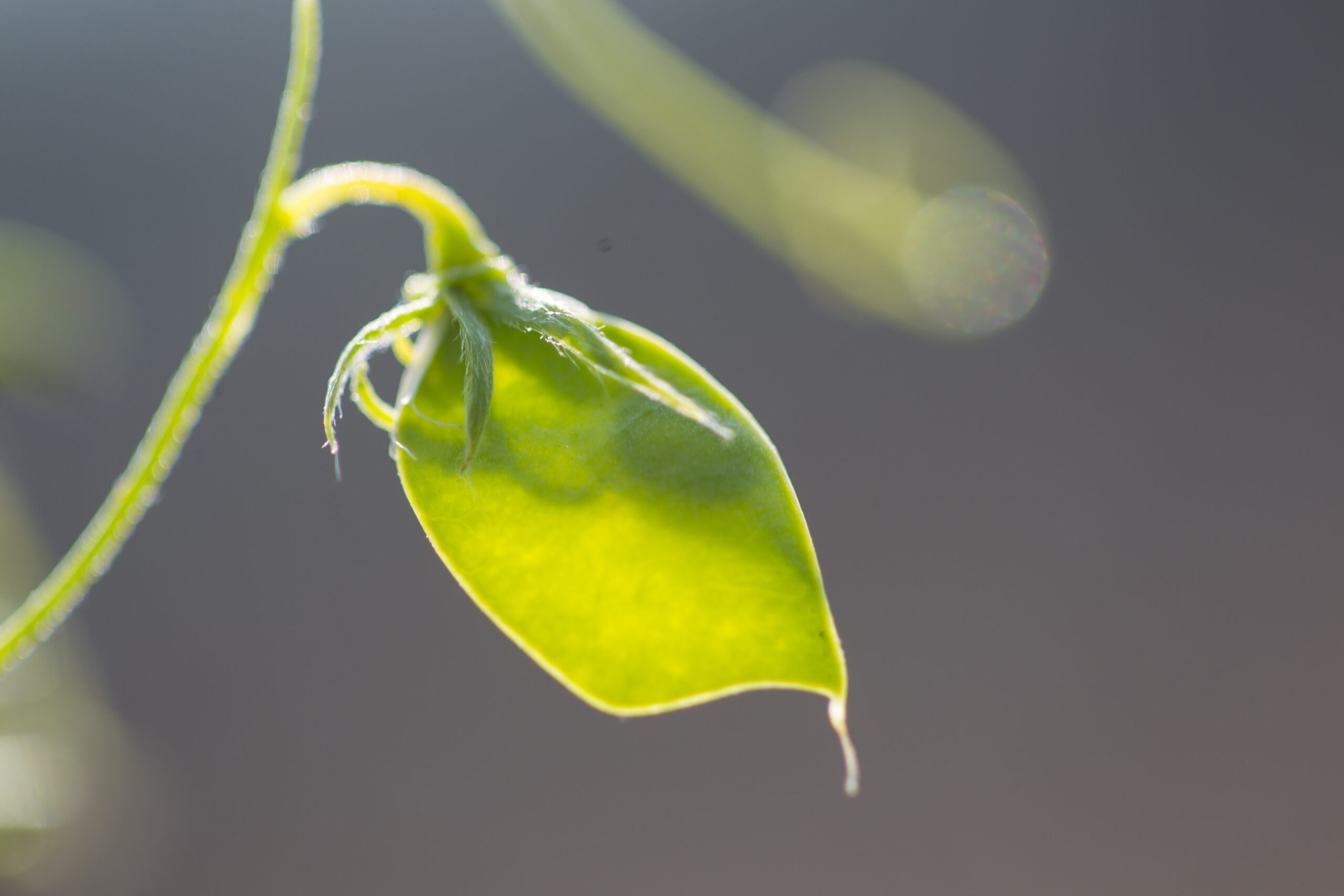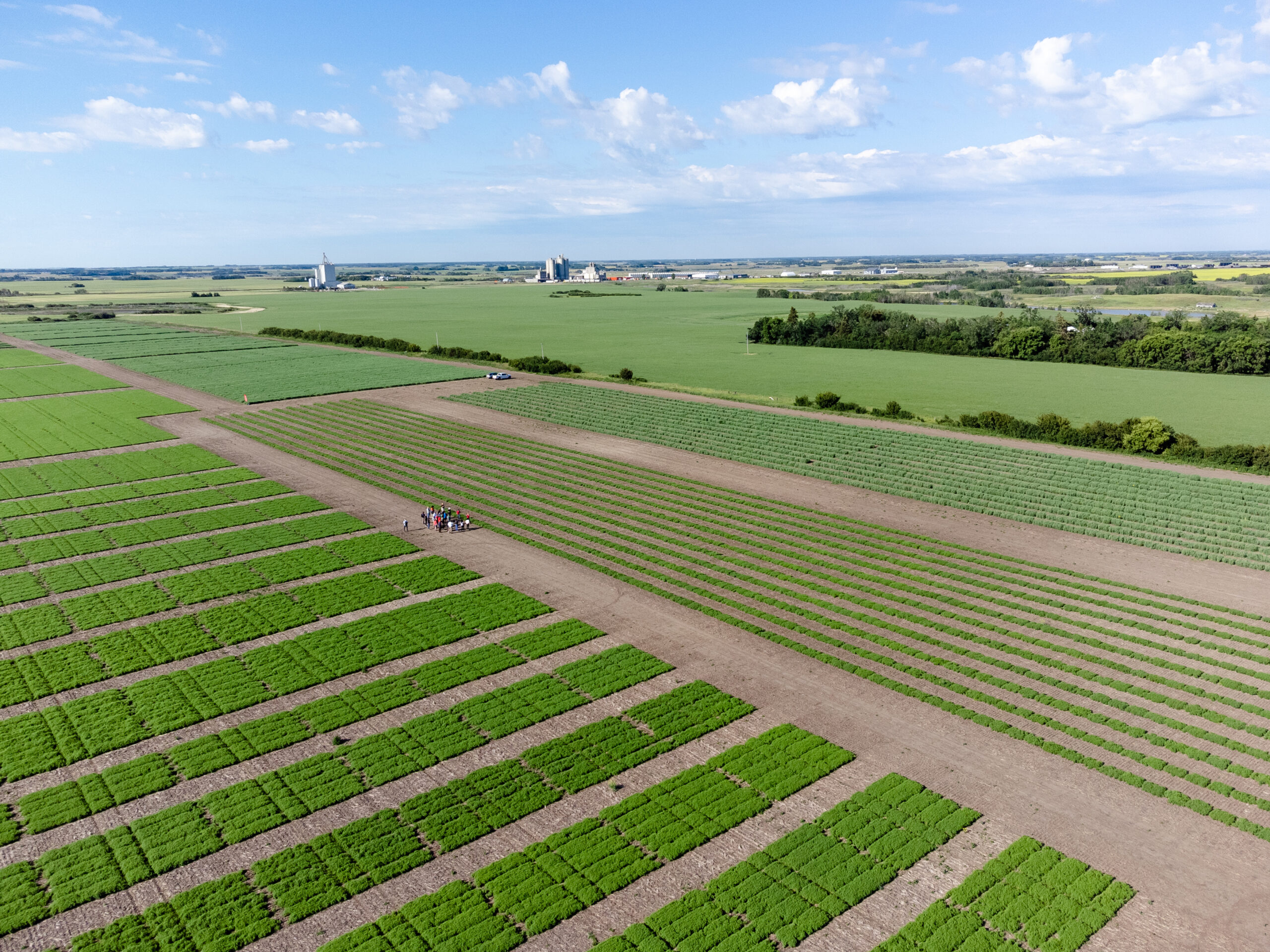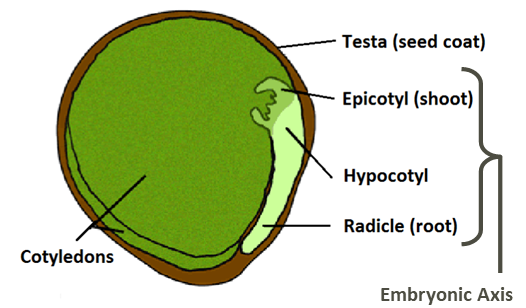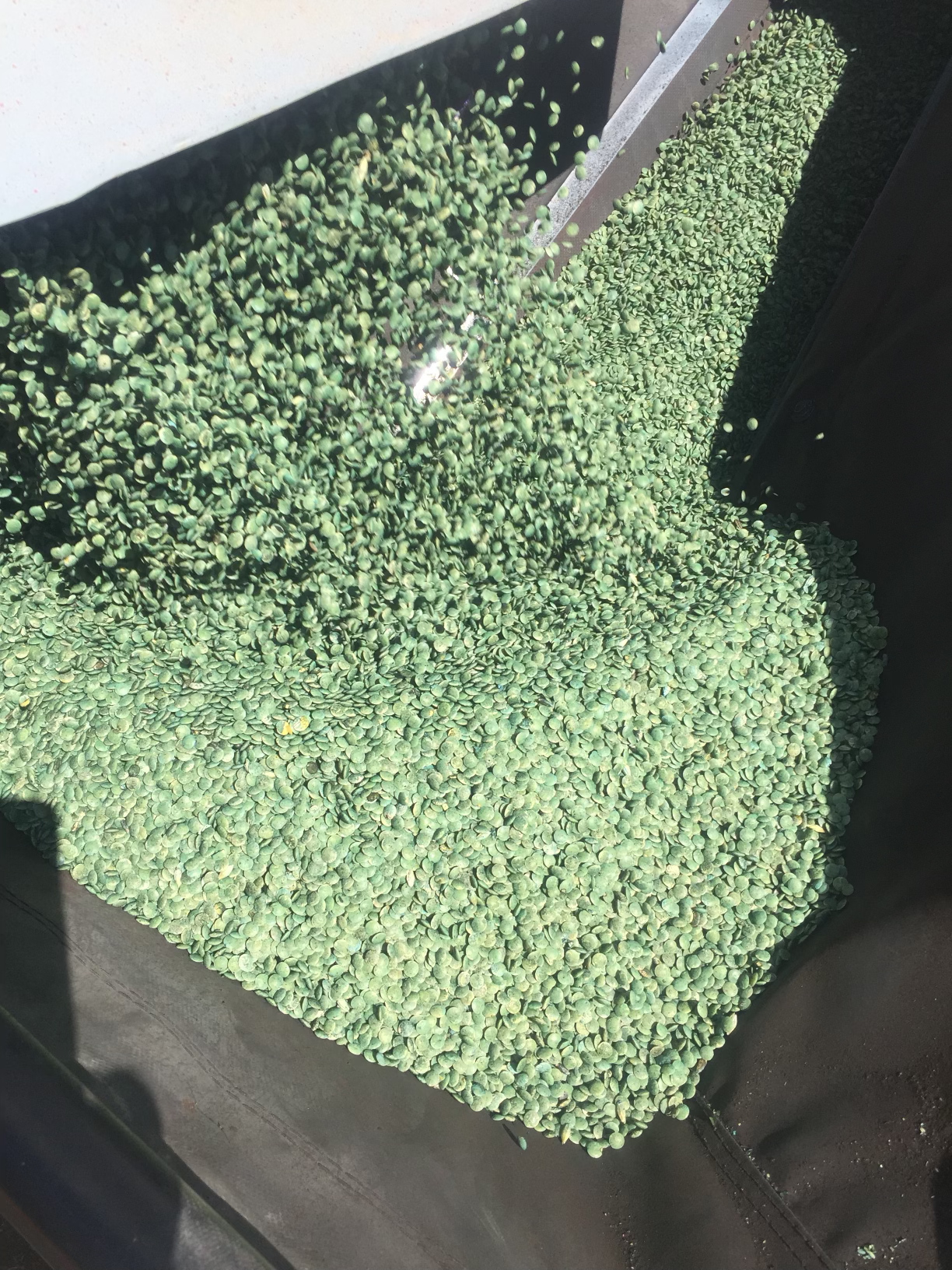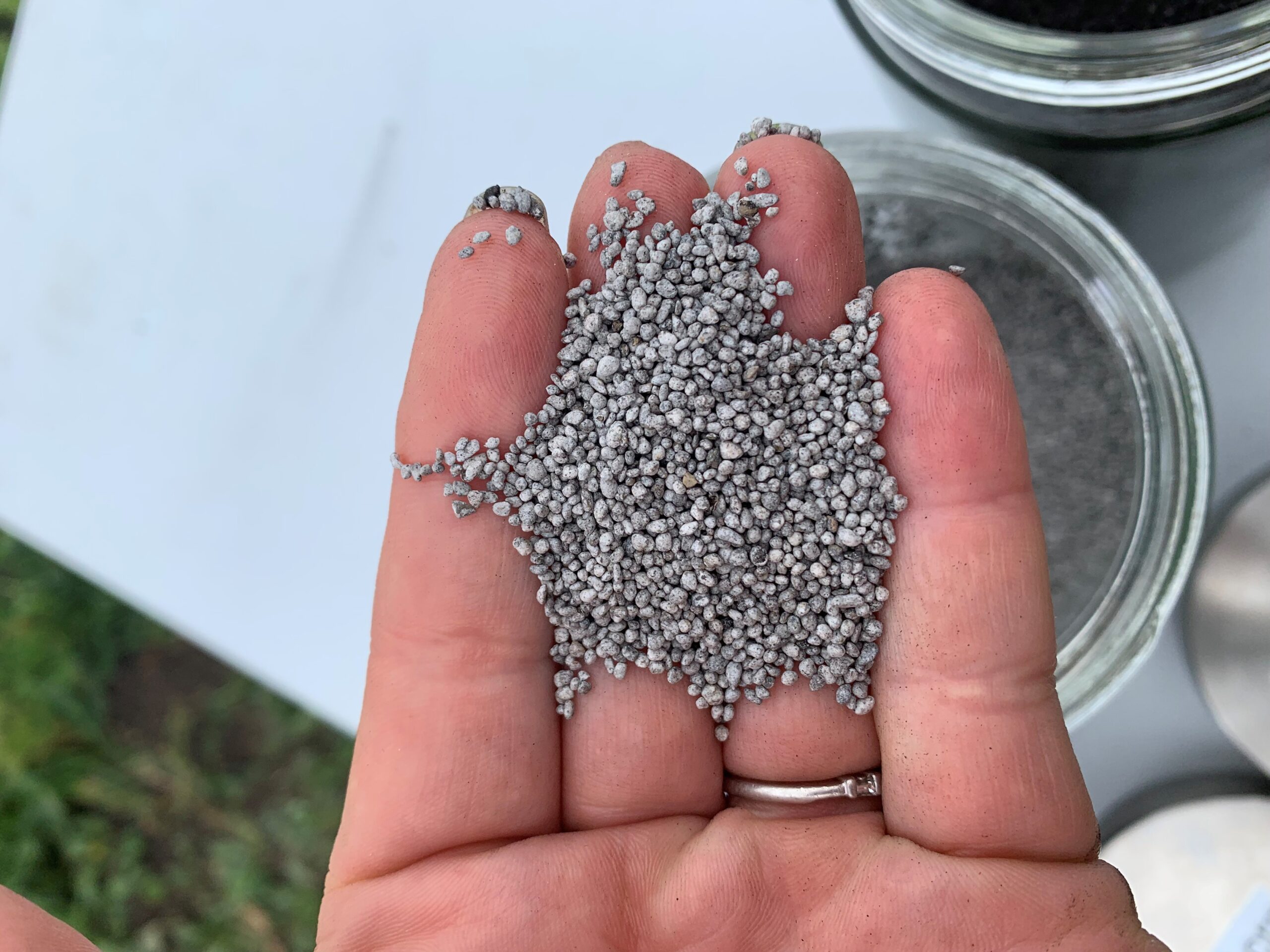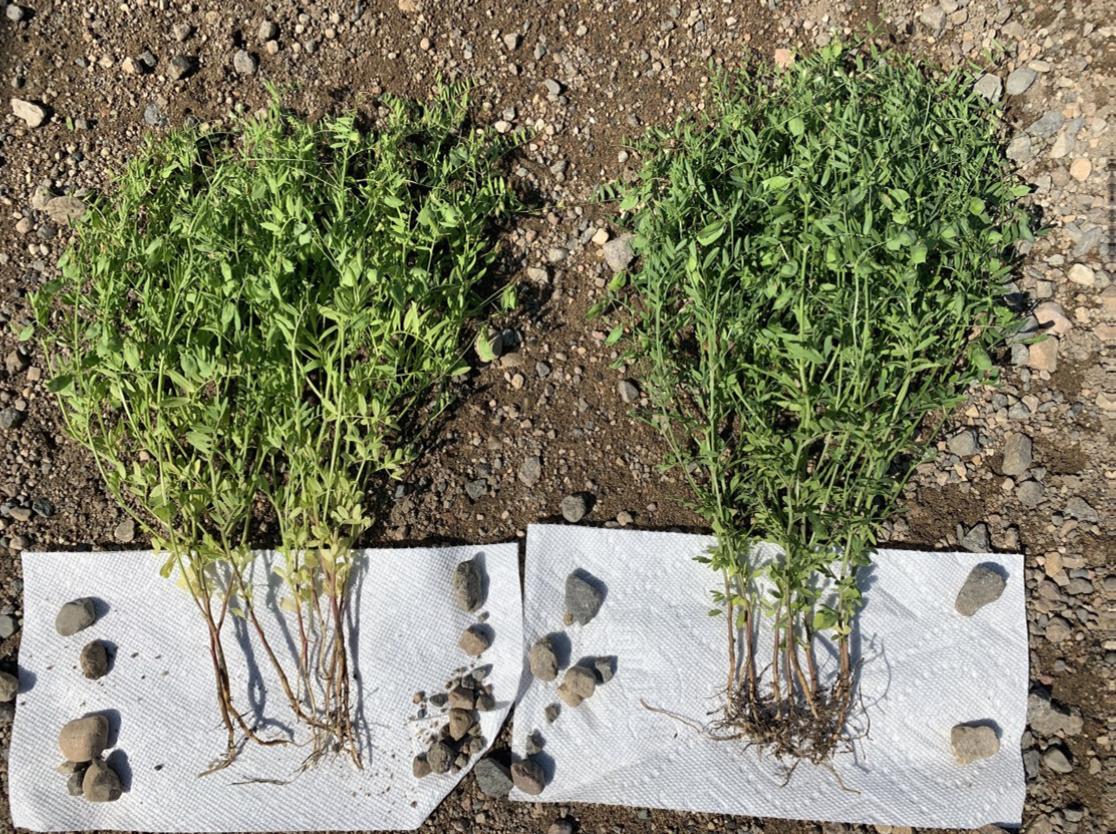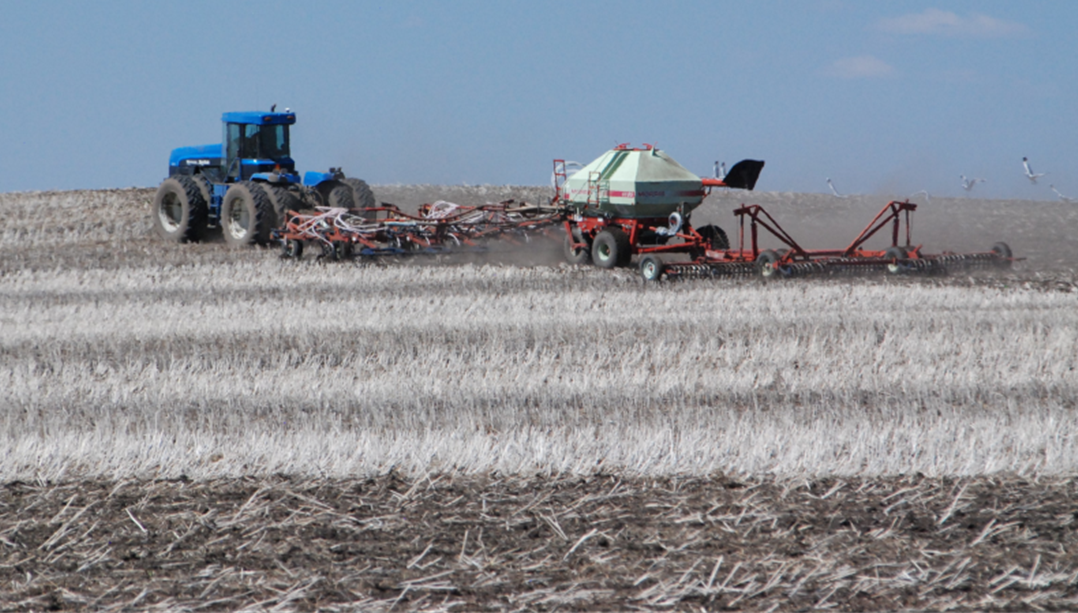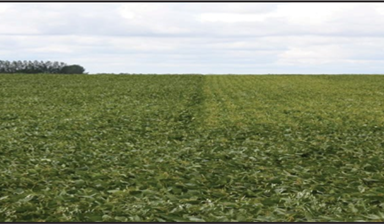Description & Adaptation
Lentil (Lens culinaris L.) is a cool-season, annual pulse crop that performs best under moderate growing conditions and is thus well-suited for growth in Western Canada. Lentils have relatively shallow root systems at less than one metre deep, and therefore require at least moderate moisture during the growing season (15 – 25 cm of precipitation).
Lentils undergo hypogeal germination, where the cotyledons remain below-ground. The first two nodes on the stem are called scale leaves, and develop at or below the soil surface. Scale leaves provide points for possible re-growth should the plant sustain injury from frost, heat, wind damage, or defoliation. The third node on the stem produces the first genuine leaf. Leaves are about 5 cm long with nine to 15 leaflets. Stipules, much smaller than leaflets, occur in pairs on either side of the leaf axis where it joins the stem. Just before flowering, new leaves will develop a short tendril at the leaf tip. At this stage, typically around the 12-node stage, the first flower clusters emerge at the leaf bases.
Lentil plants self-pollinate. Flower stalks produce one to three flowers, which develop pods. Pods are <2.5 cm long and contain one or two seeds. Vigorously growing lentil plants with adequate space will produce two or more primary shoots from the base of the stem. However, the main contribution to seed yield is made by secondary (aerial) branches that arise from the uppermost nodes of the main stem just below the first flowering node.
Due to its indeterminate growth habit, lentils continue to flower as long as growing conditions remain favourable for vegetative growth. Flowers that form later in August are not likely to produce whole seeds by harvest. Stress, such as nutrient deficiency or low moisture, is required to encourage seed set and hasten maturity. Excess moisture before the plant is in full bloom promotes vegetative growth, thereby delaying and reducing seed set, and increasing the likelihood of fungal infections.
Lentils grow best on well-drained soil with pH levels of 6.0–8.0. The crop will not tolerate flooding or soils with high salinity. In Saskatchewan, lentils are best adapted to the Brown and Dark Brown soil. The development of more determinate red and small green varieties provides an opportunity to expand lentil production into less traditional lentil-growing areas of the province, such as the moist Dark Brown and Thin Black soil zones.
Related Resources
Varieties
Lentil varieties produce seeds ranging from small to large, with sizes averaging under 40 grams per 1,000 seeds (g/1,000 seeds) to over 70 grams per 1,000 seeds.
Seed coat colours range from clear to green, tan, brown, grey, blotched green and black, or straight black. Cotyledons may be yellow, red, or green, with various combinations of seed coat and cotyledon colours determining specific market classes.
Green varieties typically have yellow cotyledons with green seed coats, and seed size is described as large, medium, or small. Green lentils are mostly sold as whole seeds. Most large green varieties require early seeding because they have later maturity and a more indeterminate growth habit. They produce taller plants that can be prone to lodging and susceptible to Botrytis (grey mould) and Sclerotinia (white mould) infections in high-moisture, dense canopy conditions.
Red varieties typically have red cotyledons with grey seed coats. Red lentils are sold as whole seeds, dehulled seeds, or dehulled split seeds, and are categorized into three market classes: large, small, and extra-small. Small red varieties tend to be earlier maturing and shorter in height than green varieties.
Specialty lentil varieties are grown in small volumes in much of Saskatchewan. Indianhead is a black-seeded lentil, initially intended for use as a green manure or plow-down crop, and has more recently been marketed as a Beluga Lentil. Large Red is a specialty red lentil market class characterized by its large seed size. Small quantities of various French green, Spanish brown, and green cotyledon market classes are produced.
Varieties with the Clearfield® trait (have CL suffix) have a tolerance to imidazolinone herbicides that would otherwise cause injury to conventional lentils.
Varieties differ in their height, maturity, and resistance to ascochyta and anthracnose. Small red varieties tend to be earlier maturing and shorter than large green varieties. Most varieties are now rated Moderately Resistant (MR) to Ascochyta Blight and Anthracnose Race 1. Race 0 is the more common and virulent race that lentil growers encounter in Saskatchewan, and efforts are underway to identify and introduce resistance to this race in future varieties. Integrated disease management practices need to be considered as diseases can still infect the varieties.
Want to see how different varieties compare?
Visit the Interactive SaskSeed Guide for information on all lentil varieties available to Saskatchewan producers.
Clearfield® Production System & Stewardship Guidelines
BASF has revised their requirements for growing Clearfield® lentils. A signed Clearfield® Commitment form is no longer required and has been replaced with the Stewardship Guidelines for Clearfield® Lentil. The Stewardship Guidelines are designed to ensure long-term sustainability of the Clearfield Production System for lentils by preventing or delaying the development of herbicide resistance in weed populations. Please review the guidelines.
Key Points
- Source seed either directly from your local seed grower or use good-quality farm-saved seed.
- Get your farm-saved seed Clearfield-Confirm® tested at an independent seed laboratory facility approved by BASF as listed in the guidelines. The use of certified seed and farm-saved seed that has passed the Clearfield-Confirm Test ensures an acceptable degree of herbicide tolerance trait expression in the Clearfield variety purchased and planted.
For growers who opt to participate in the Clearfield Seed Quality Offer Program, BASF will cover the cost of the Clearfield-Confirm Test.
Seeding
Lentil seedlings tend to be vigorous and can emerge through crop residue, growing from considerable seeding depths.
Studies conducted by Agriculture and Agri-Food Canada at Swift Current found that lentils seeded on untilled stubble from the previous crop produced higher yields than those seeded on tilled fields. As the stubble height increased, so did the lentil yield.
Additionally, the height of the lowest pod on the lentil plant increased in tandem with stubble height. Higher pods can make combining easier and can reduce shatter loss during harvest.
Seeding lentils into tall stubble helped retain soil moisture, particularly before flowering, resulting in greater crop water use efficiency.
Lentil fields are usually rolled with a land roller following seeding or up to the fourth node stage. Rolling levels the soil, protects harvest equipment by pressing rocks into the ground, and reduces the risk of downgrading the harvest sample with dirt contamination (earth tag).
Related Resources
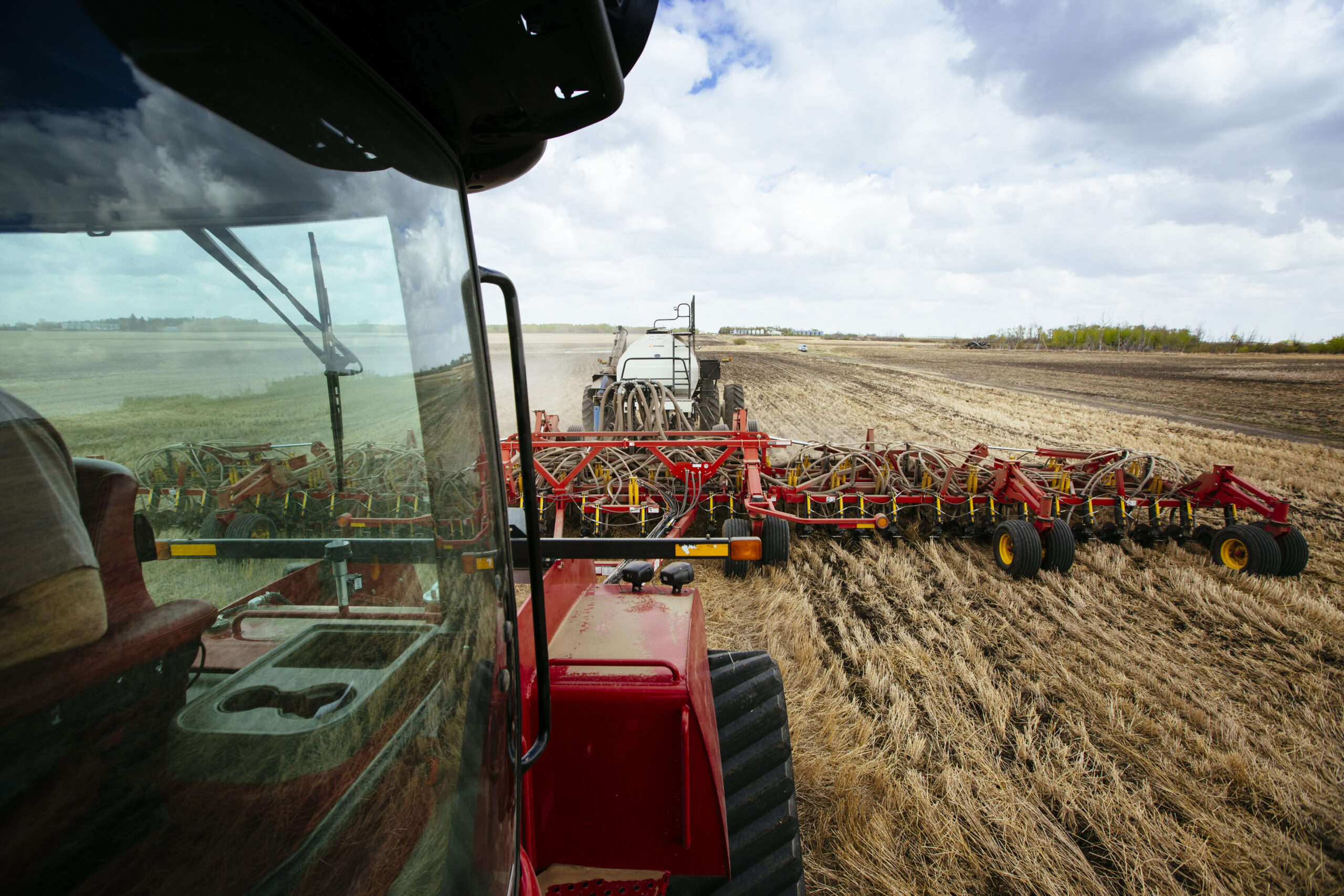
Calculating Seeding Rates
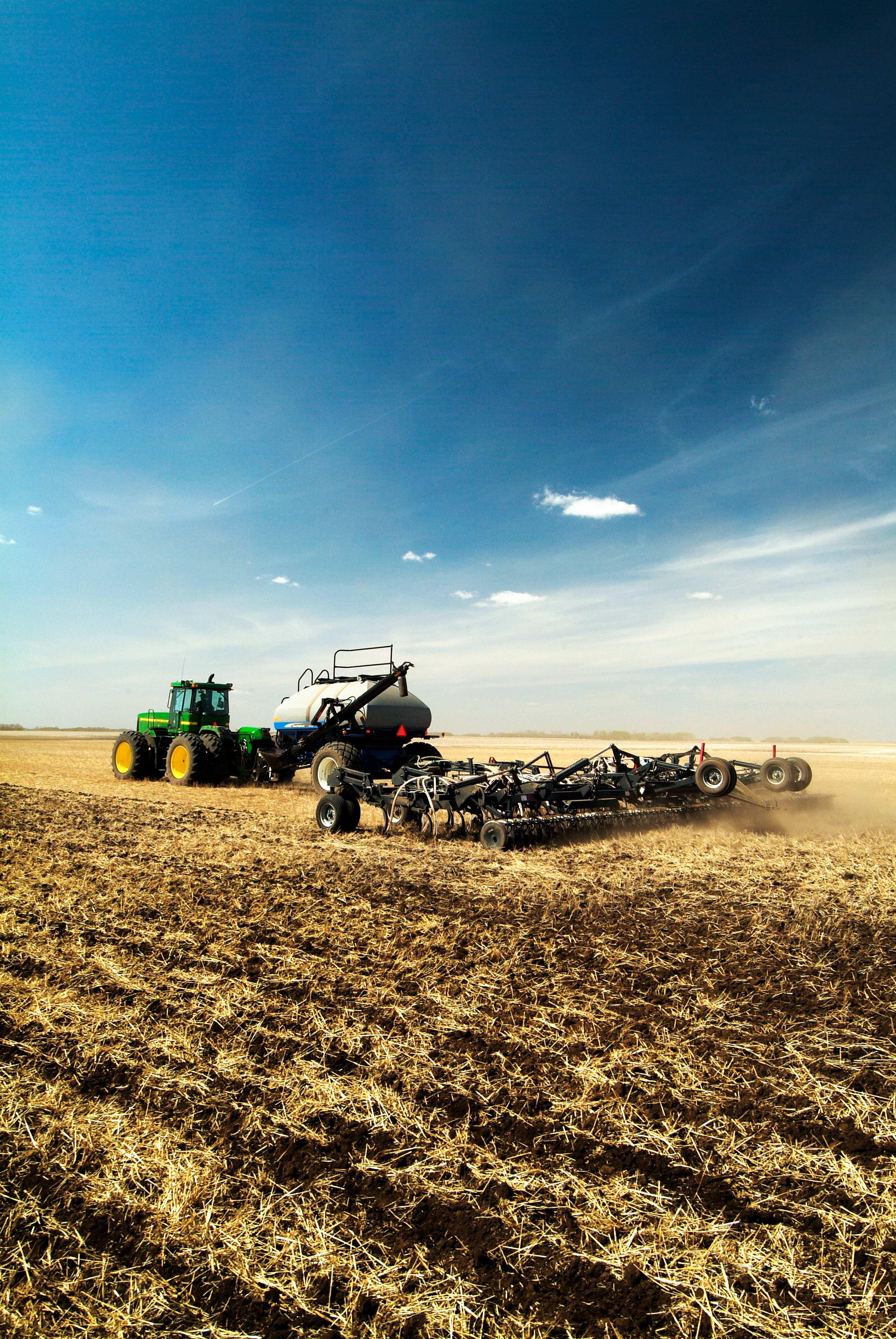
Seeding Tips For Pulse Crops
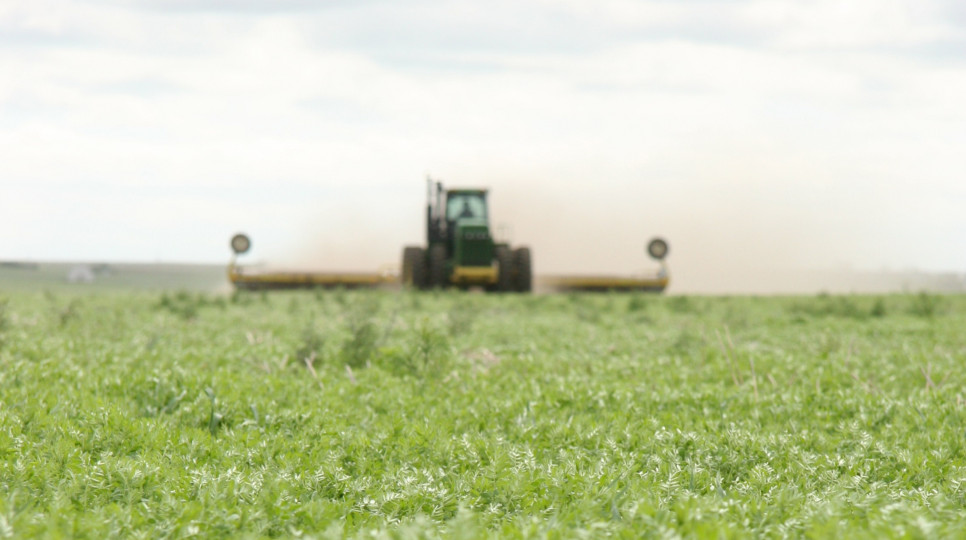
Tips for Rolling Your Pulse and Soybean Crops
Inoculation & Fertility
Lentils inoculated with the proper rhizobium strain (Rhizobium leguminosarum) can secure up to 80% of their nitrogen requirements through atmospheric nitrogen fixation.
Atmospheric nitrogen fixation is a symbiotic relationship in which the plant provides energy to the Rhizobium nodules in the form of carbohydrates, and the Rhizobium, in return, converts atmospheric nitrogen into a form that the plant can use. This relationship provides maximum benefit when the supply of available soil nitrogen is low and the soil moisture and temperature levels are adequate for normal seedling development.
Rhizobium leguminosarum strains will nodulate peas, faba beans, and lentils, but some strains may be more effective on specific crops or certain varieties. Manufacturers package the inoculant as either a mixed-strain or single-strain inoculant.
Rhizobium bacteria are susceptible to temperature stress, dehydration, and damage from direct sunlight, so proper handling is crucial. The inoculant must be stored in a calm, dark environment before use, and expiry dates must be strictly observed. Inoculated seed should be planted as soon as possible.
Inoculants are sensitive to granular fertilizer. Therefore, banding fertilizer to the side and/or below the seed is recommended. Inoculants should never be tank-blended with fertilizers. Inoculants are also sensitive to some seed-applied fungicides. Check the labels of both the inoculant and seed treatment for compatibility. When using a combination of fungicide and inoculant, apply the fungicide to the seed first, allow it to dry, and then apply the inoculant immediately before seeding.
Inoculants are available as liquid, peat-based, and granular formulations.
- Liquid-based products offer convenience and better control of application rate, compared to other forms. If treated seed is planted immediately into a moist seedbed, liquid formulations perform well. However, the rhizobia in these formulations are more susceptible to damage from environmental extremes and direct contact with seed treatments than other inoculant forms.
- Peat-based formulations are less prone to desiccation and damage from direct contact with seed treatments compared to liquid formulations. Some peat-based powder inoculants require the use of a sticker. Adhesion to the seed can be enhanced if the seed is slightly damp during inoculation.
- Granular formulations offer ease of application and are applied in-furrow. These formulations eliminate the risk of incompatibility with seed treatments; however, care must still be taken to minimize the risk of desiccation. Granular inoculants are less affected by environmental stress and seed-applied fungicides than other inoculant forms.
All inoculant formulations will perform equally well if the inoculant is applied correctly and if environmental conditions are ideal. Under adverse conditions, granular formations tend to perform best, followed by peat, then liquid.
Although Rhizobium bacteria can live in the soil for several years, efficient nitrogen-fixing bacteria may not be among those that survive in the soil. As such, it is advisable to inoculate every time lentils are seeded to achieve maximum yield potential.
Checking Nodulation
The best way to check for nodulation is to dig up a plant and gently remove the soil from the roots by rinsing with water. It may take three to four weeks after germination before nodulation can be evaluated. Nodules are easily identified as small, round growths on the roots of plants. If nitrogen fixation is active, the nodules will be pink or red on the inside. The lack of nodules indicates that rhizobia did not infect the plant. Green, cream, or brown-coloured nodules indicate that the rhizobia are not fixing nitrogen.
Nitrogen fixation is synchronized with plant growth, supplying the crop with nitrogen during rapid vegetative growth. Nitrogen fixation declines as plants begin to form pods and seeds.
Soil testing is essential. Nitrogen is necessary for high yields, but nitrogen fertilizer application is generally not required for lentil. Lentils can fix up to 80% of their nitrogen requirements through nitrogen fixation, with the remaining 20% sourced from the soil, utilizing what is available at the time of seeding, as well as what is mineralized during the growing season. High soil nitrogen levels will adversely affect nodulation and fixation. As the supply of nitrogen from soil and fertilizer increases, the plants get ‘lazy’ and the amount of nitrogen fixed by the plant decreases.
Where combined levels of soil and fertilizer nitrogen reach 28–40 kg per hectare (kg/ha) or 25–35 pounds per acre (lb/ac), development of nodules and nitrogen fixation may be delayed. Combined soil and fertilizer nitrogen levels greater than 55 kg/ha (50 lb/ac) can prevent effective nodulation and nitrogen fixation.
Early plant growth may be poor in soils with nitrogen levels below 11 kg/ha (10 lb/ac), causing plants to appear yellow before the onset of active nitrogen fixation due to nitrogen deficiency. This early deficiency can be corrected by adding low levels (10–15 kg/ha) of starter nitrogen at seeding. Although high levels of starter nitrogen may appear to help the crop overcome a nitrogen deficiency during early crop growth stages, final seed yields may not increase. Typical application levels of monoammonium phosphate (MAP) (ex., 12-51-0) often provide the slight boost of nitrogen needed for early plant growth.
Phosphorus promotes the development of extensive root systems and vigorous seedlings. Encouraging vigorous root growth is a crucial step in promoting healthy nodule development, nitrogen fixation, and achieving earlier and more uniform maturity.
Lentils have a relatively high requirement for phosphorus. Lentils grown in soils testing low in available phosphorus or under cool, wet conditions may respond positively to phosphate fertilizer, but dramatic yield responses are not always achieved. Even if seed yield increases are not achieved every year, a lentil crop may benefit from improved stress tolerance because of phosphorus application.
The maximum safe rate of actual phosphate applied with the seed is 22 kg/ha (20 lb/ac) with 10–15% seedbed utilization (SBU) under good to excellent moisture conditions. Calculate SBU by dividing seed spread by row spacing. For example, a 2.5 cm (1 in) spread with 25.4 cm (10 in) row spacing equates to 1/10 or 10% SBU. Rates of seed-placed phosphate should be reduced if poor soil moisture conditions exist. Higher rates of phosphate fertilizer placed in the seed row with narrow openers, such as discs or knives, can damage the emerging seedling and reduce the stand. If higher phosphate rates are required, band the fertilizer away from the seed (sideband or to the side and below) or increase phosphate levels in the years preceding lentil growth.
Lentils have a high demand for potassium. Use a soil test to determine whether additional potassium is needed. Seed-placing potassium may cause seedling damage. As with phosphate, a wider opener may allow for slightly higher safe seed-placed rates. The sum of seed-placed potassium (K2O) plus phosphate fertilizers must not exceed the recommended safe rate of phosphate mentioned previously (22 kg/ha or 20 lb/ac). Most of the potassium taken up remains with the soil residue and is not removed with the grain. Most soils are sufficient in potassium. However, deficiencies may exist, especially in sandy Black and Grey soils found in Northern Saskatchewan. Fertility requirements should be determined based on soil test results.
Sulphur is required in a relatively significant amount. A 30 bu/ac lentil crop requires about the same amount of sulphur as a 40 bu/ac wheat crop; approximately 9–11 kg/ha (8–10 lb/ac), as lentils remove about 0.2 lb/bu of sulphur. Soils testing low in available sulphur should have this deficiency corrected by side-banding, mid-row banding, or broadcasting ammonium sulphate, which contains sulphur in a plant-available form. Most research indicates a limited yield response to the addition of sulphur fertilizer, except in fields testing very low in sulphur.
Micronutrient deficiencies for lentil production have not been identified as a problem in Western Canada. If a micronutrient deficiency is suspected, it is advisable to analyze soil and plant samples within the suspect area and compare the analysis to soil and plant samples collected from a non-affected area of the same field. If the study confirms a micronutrient deficiency at a relatively early growth stage, a foliar application of the appropriate micronutrient fertilizer may correct the problem.
